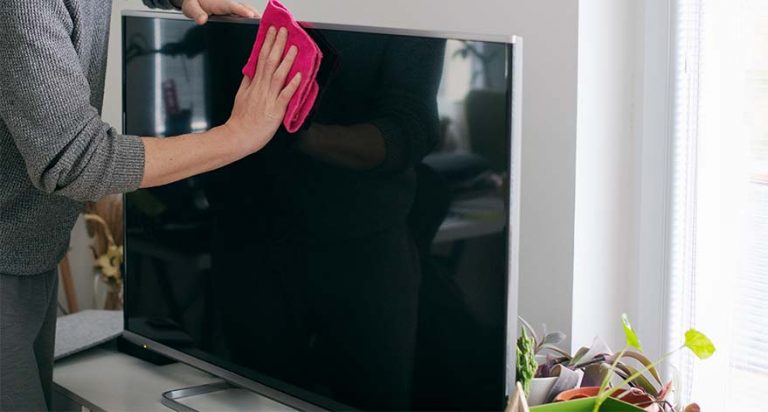An Episode on How to Safely Clean Your Flat Screen TV
How to Clean a Flat Screen TV
Television screens have come a long way from the previously common and bulky CRT sets to the modern flat screen LCD and OLED panels. The cathode ray tube (CRT) televisions were too bulky to allow for the manufacture of larger screen sizes. However, the flat screen display format allows for the manufacture of larger sizes that currently reach 85 inches.
Flat screen TVs come in two technologies that comprise plasma and liquid crystal display or LCD. Other variations include LED technology that uses light-emitting diodes to backlight the screen. On the other hand, plasma screens auto-light using ultraviolet light-emitting gas cells. The common features between these formats are flat screens and slim frames that are currently average 1 inch in thickness.
The LCD and LED-lit televisions are more energy efficient than plasma, but there has been some significant improvement and plasma is catching up. The LEDs are a bit pricy but have a longer life span than plasma, though plasma has a slight edge on picture quality.
Flat screen TVs offer better picture quality, larger screen sizes, smart features that link you to the internet and they are lightweight. Their slim formats are good for space-saving since they can be wall-mounted easily for a great viewing experience, but how do you clean a flat screen TV?
How Do You Clean a Flat Screen TV?
The good old cathode ray tube came with an easy-to-clean glass screen and did not present any challenge to owners. However, LCD screens are made from a delicate type of flexible plastic that is sensitive to harsh chemical detergents.
Plasma TV screens are made from delicate glass that is sensitive to abrasive materials that can leave unsightly scratch lines. Therefore, you must understand your screen type and go by the manufacturer’s recommendations when cleaning. The user manual that comes with your TV will provide you the best guidance in this regard.
Even then, with knowledge of your screen type, you can still save on expensive specialty cleaning agents from the store and use what is readily available at home. You will find that most flat screen cleaning is simple and there is not much to it.
Dusting Your TV
Depending on your neighborhood and time of year, dust is the first cleaning problem you will deal with more frequently. Wet cleaning cloths may not yield desired results and can cause more smudging, potentially damaging some delicate types of LCD and plasma screens. A soft, dry microfiber cloth might do the trick quite well against dust on your set.
Using a soft, anti-static microfiber cloth, start with the screen and use gentle circular motions to dust. Now, take care not to tip over your TV if it is on a stand by holding it with one hand as you clean with the other. A good safety measure here would be to firmly anchor your TV with purpose-made anti-tipping straps or mount it on the wall.
Remember to wipe clean the cabinet as well to keep the vents clear of obstructions for easier heat dissipation. If your TV is wall-mounted, dust the area around the TV for general cleanliness.
Removing Fingerprints and Stains
To remove stubborn stains, dampen the cloth with distilled water and wring it out before using it to clean. Once again, be gentle and avoid applying pressure on the screen as this can cause abrasions. Do not spray any cleaning liquid directly onto the screen, as the drip off can seep into the inner components and cause shock.
If you must use some detergent, then prepare a highly diluted dish soap solution that you will then apply to the cloth and gently clean your screen with. Whenever you use a damp cloth to clean your flat screen, remember to go over it again with a soft, dry microfiber cloth to remove any streaks for a perfect finish.
A word of caution: plasma screens are made of glass but have delicate anti-glare coatings that can suffer damage if cleaned the same way you would a CRT. Use the same method for LCDs, LEDs or OLEDs
Cleaning the Remote Control
Television sets come with remote controls that are, in fact, handled by many hands in normal usage. This leaves stains and grease on the piece, not to mention pathogens. With common colds and flu, it is not surprising that viruses can spread through this gadget.
You must clean your remote control as well. Remove batteries before you start the cleaning, then with the buttons facing down, tap it against your other palm to dislodge any dirt stuck between the keys.
Use a dry toothpick to pry out any dirt that is still stuck and then dampen a cotton swab with mild alcohol to finish the cleaning between the buttons. Wipe the whole remote with a soft cloth sprayed with a mild alcohol solution before finishing it off with a dry, soft cloth and then reinstall the batteries.
Tips for Easy Flat Screen Cleaning:
- To keep your flat screen TV in pristine condition, keep a regular cleaning schedule to avoid dust and grime buildup. At the least, clean your set on a weekly schedule to keep in check any unsightly dirt.
- Strictly follow the manufacturer’s recommendations to retain your consumer benefits under warranty in the event of a malfunction.
- When cleaning TV screens, do not use liquids, nor directly spray a solution onto the set to avoid shock and component failure.
- Do not use harsh cleaning solutions that contain acetone, alcohol and ammonia, as these will damage the screen.
- Set your vacuum at low suction to clear dust from cable connections, ports and vents.
- You can mix a homemade cleaning solution using what you normally have in the kitchen pantry and clean your screen at no extra cost. You will need two microfiber cloth pieces, one for the damp cleaning and the other for buffing.
- For your home cleaning solution, you will require some white vinegar and distilled water. Mix these in a bowl at equal proportions and you have a perfect cleaning solution that is gentle on your screen.

